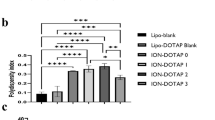Abstract
The aim of this study was to prepare the liposome with 1,2-distearoyl-sn-glycero-3-phosphocholine, 1.2 dioleoyl-sn-glycero-3-phosphoethanolamine, cholesteyl hemisuccinate, calcein as a drug model and evaluate physicochemical characteristics such as particle size, polydispersity index (PDI), encapsulation efficiency (EE). Also, the morphology of the blank liposome (without calcein) and the calcein-loaded liposome was observed by a transmission electron microscope (TEM). The particle size and PDI of the blank liposome and the calcein-loaded liposome without tween 80 were 139.8 ± 4.497, 0.31 ± 0.03 and 150.8 ± 8.45, 0.29 ± 0.03 nm, respectively. In addition, it was confirmed that the particle size of the calcein-loaded liposome increased from 294. 6 ± 17.8 to 466.4 ± 78.4 nm when tween 80 was used from 1 to 6%. EE of the calcein-loaded liposome was 66.0 ± 0.58%, independent of the concentration of tween 80. TEM images showed that the shape of the blank liposome and the calcein-loaded liposome was round. In vitro drug release test, calcein from the liposome released approximately 20–25 and 40–50% in pH 7.4 and 4.0, respectively, with a sustained release pattern. The cellular uptake of calcein from the calcein-loaded liposome was about 1.08-fold than that from the calcein solution at 10 µM for a 2 h incubation time. These results suggest that the calcein-loaded liposome was successfully prepared, and could be an application for a hydrophilic drug in further study.





Similar content being viewed by others
References
Allen TM, Hansen C, Martin F, Redemann C, YanYoung A (1991) Liposome containing synthetic lipid derivatives of poly(ethylene glycol) show prolonged circulation half- lives in vivo. Bicochim Biophys Acta 1006:29–36
Bergstrand N (2003) Liposomes for drug delivery from physico-chemical studies to applications. Comprehensive Summaries of Uppsala Dissertations from the Faculty of Science and Technology
Chena Y, Minh LV, Liua J, Angelov B, Drechsler M, Garamus VM, Willumeit-Römerd R, Zoua A (2016) Baicalin loaded in folate-PEG modified liposomes for enhanced stability and tumor targeting. Colloids Surface B 140:74–82
Cho SM, Lee HY, Kim JC (2008) pH-dependent release property of dioleoylphosphadiylcholine ethanolamine liposome. Korean J Chem Eng 25:390–393
Cullis PR, Kruijff BDE (1979) Lipid polymorphism and the functional roles of lipids in biological Membranes. Biochim Biophys Acta 559:339–420
Ducat E, Evrard B, Peulen O, Piel G (2011a) Cellular uptake of liposomes monitored by confocal microscopy and flow cytometry. J Drug Del Sci Tech 21:469–477
Ducat E, Deprez J, Gillet A, Noël A, Evrard B, Peulen P, Piel G (2011b) Nuclear delivery of a therapeutic peptide by long circulating pH-sensitive liposomes: benefits over classical vesicles. Int J Pharm 420:319–332
Ellens H, Bentz J, Szoka FC (1984) pH-induced destabilization of phosphatidylethanolamine-containing liposomes: role of bilayer contact. Biochemistry 23:1532–1538
Eloy JO, de Souza MC, Petrilli R, Barcellos JPA, Lee RJ, Marchetti JM (2014) Liposomes as carriers of hydrophilic small molecule drugs: strategies to enhance encapsulation and delivery. Colloids Surf B 123:345–363
Jiang M, Gan L, Zhu C, Dong Y, Liu J, Gan Y (2012) Cationic core–shell liponanoparticles for ocular gene delivery. Biomaterials 33:7621–7630
Jin S, Ye K (2007) Nanoparticle-mediated drug delivery and gene therapy. Biotechnol Prog 23:32–41
Kim JS (2016) Liposomal drug delivery system. J Pharm Investig 46:387–392
Lee RJ, Low PS (1995) Folate-mediated tumor cell targeting of liposome-entrapped doxorubicin in vitro. Biochim Biophys Acta 1233:134–144
Lee Y, Graeser R, Kratz F, Geckeler (2011) Paclitaxel loaded polymer nanoparticle for the reversal of multidrug in breast cancer cells. Adv Funt Mater 21:4211–4218
Litzinger DC, Huang L (1992) Phosphatodylethanolamine liposomes: drug delivery, gene transfer and immunodiagnostic applications. Biochim Biophys Acta 1113:201–227
Liu D, Huang L (1990) pH-sensitive, plasma-stable liposomes with relatively prolonged residence in circulation. Biochim Biophys Acta 1022:348–354
Liu X, Sun W, Zhang B, Tian B, Tang X, Qi N, He H, Li H, Jin X (2013) Clarithromycin-loaded liposomes offering high drug loading and less irritation. Int J Pharm 443:318–327
Maheswaran A, Brindha P, Mullaicharam AR, Masilamani K (2013) Liposomal drug delivery systems—a review. Int J Pharm Sci Rev Res 23:295–301
Needham D, Nunn RS (1990) Elastic deformation and failure of lipid bilayer membranes containing cholesterol. Biophys J 58:997–1009
Seddon JM (1990) Structure of the inverted hexagonal (HII) phase, and non-lamellar phase transition of lipids. Biochim Biophys Acta 1031:1–69
Smaby JM, Momsen MM, Brockman HL, Brown RE (1997) Phosphatidylcholine acyl unsaturation modulates the decrease in interfacial elasticity induced by cholesterol. Biophys J 73:1492–1505
Straubinger RM, Düzgünes N, Papahadjopoulos D (1984) pH-sensitive liposomes mediate cytoplasmic delivery of encapsulated macromolecules. FEBS Lett 179:148–154
Voinea M, Simionescu M (2002) Designing of ‘intelligent’ liposomes for efficient delivery of drug. J Cellular Mol Med 6:465–474
Xu H, James W, Wu Z (2015) Enhanced pH- responsiveness, cellular trafficking, cytotoxicity and long-circulation of PEGylated liposomes with post-insertion technique using gemictabine as a model drug. Pharm Res 32:2428–2438
Acknowledgements
This article does not contain any studies with human and animal subjects performed by any of the authors. All authors (S.M Han, Y.G. Na, H.S. Lee, G.H. Son, S.H. Jeon, K.H. Bang, S.J. kim, H.J. Lee, C.W. Cho) declare that they have no conflict of interest. This work was supported by the research fund of Chungnam National University. We’d like to thank Ms. Youngjoo Sul for proofreading this manuscript.
Author information
Authors and Affiliations
Corresponding author
Rights and permissions
About this article
Cite this article
Han, SM., Na, YG., Lee, HS. et al. Improvement of cellular uptake of hydrophilic molecule, calcein, formulated by liposome. J. Pharm. Investig. 48, 595–601 (2018). https://doi.org/10.1007/s40005-017-0358-0
Received:
Accepted:
Published:
Issue Date:
DOI: https://doi.org/10.1007/s40005-017-0358-0




